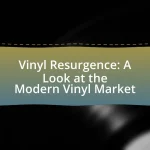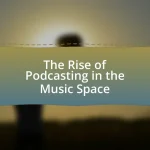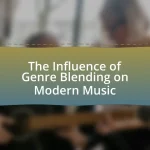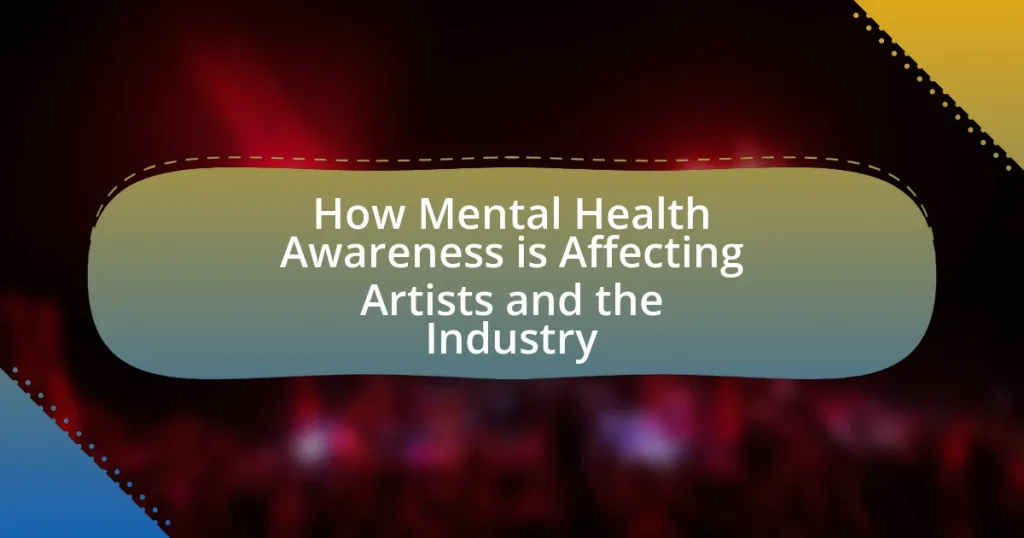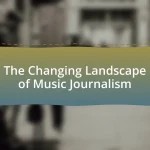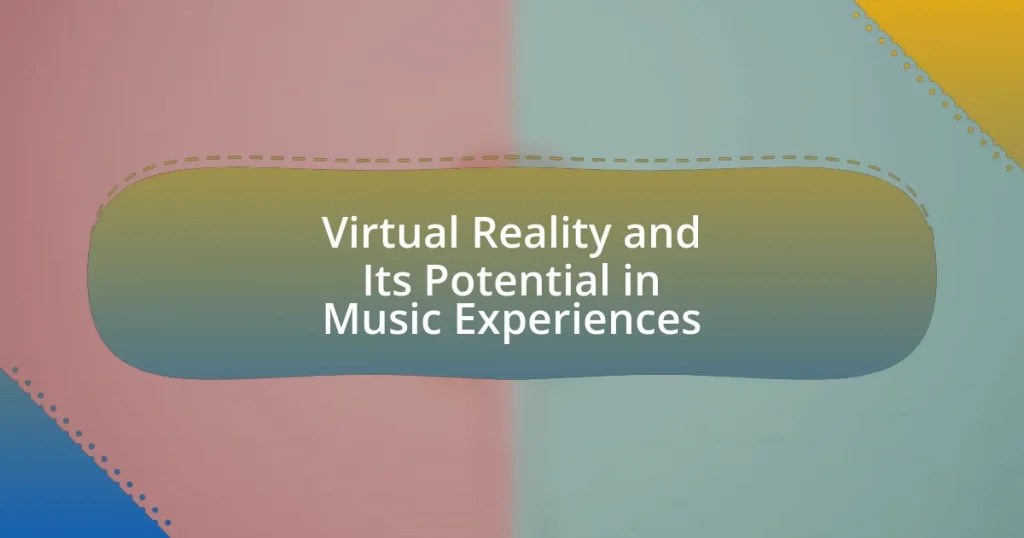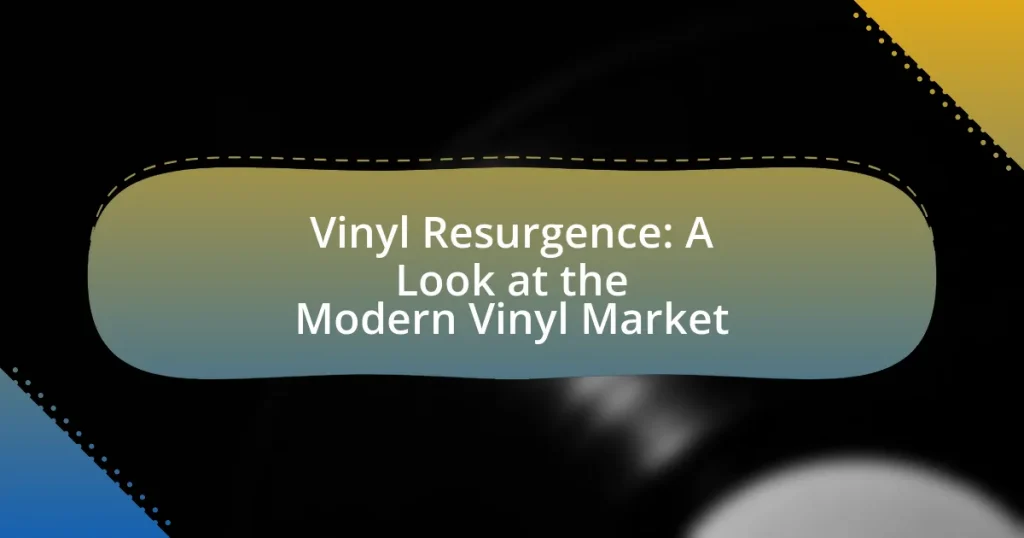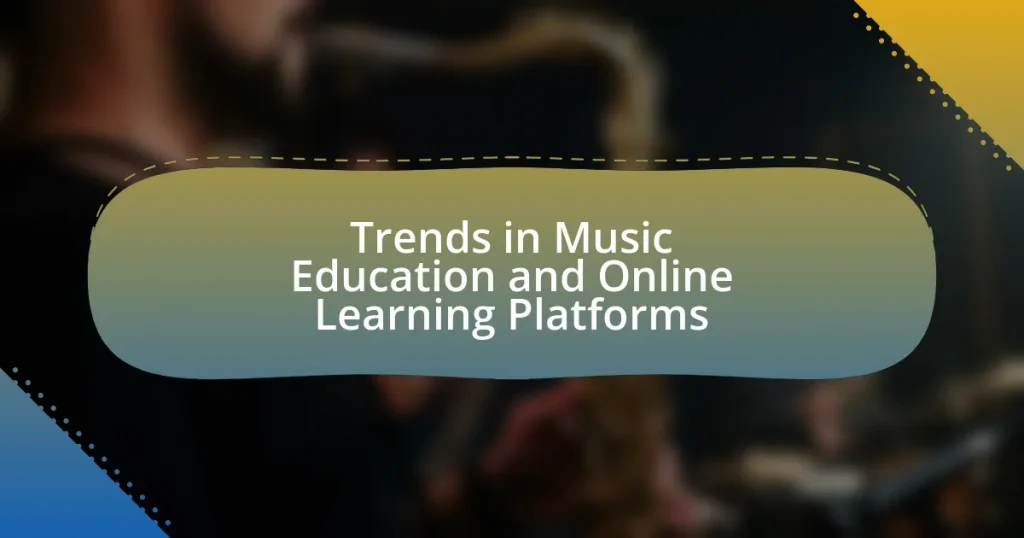Mental health awareness is profoundly influencing artists and the creative industry by promoting open discussions about mental health challenges and integrating wellness into artistic processes. A significant percentage of artists report experiencing mental health issues, highlighting the urgent need for support systems and resources. The article explores key factors driving this awareness, including societal changes, the role of social media, and the impact on creativity and artistic expression. It also examines the industry’s response through initiatives aimed at supporting artists’ mental health, the importance of community engagement, and practical steps artists can take to prioritize their well-being.
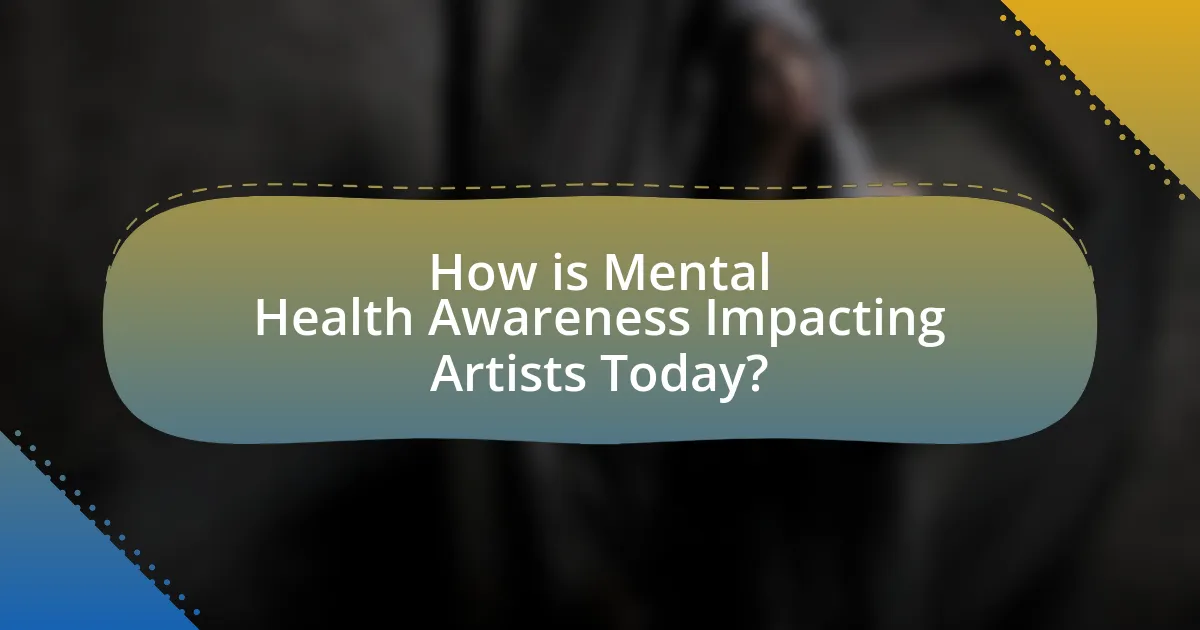
How is Mental Health Awareness Impacting Artists Today?
Mental health awareness is significantly impacting artists today by fostering open discussions about mental health challenges and encouraging the integration of mental wellness into creative processes. This shift is evident as many artists openly share their struggles with mental health, leading to a more supportive community and reducing stigma. For instance, a survey by the Creative Industries Federation in 2021 found that 87% of creative professionals reported experiencing mental health issues, highlighting the urgent need for awareness and support. Furthermore, initiatives like the “Time to Change” campaign in the UK have successfully promoted mental health conversations, resulting in increased resources and support systems for artists. This cultural change not only enhances individual well-being but also influences the themes and narratives present in contemporary art, making mental health a central topic in artistic expression.
What are the key factors driving mental health awareness in the arts?
Key factors driving mental health awareness in the arts include increased visibility of mental health issues, advocacy from artists, and the integration of mental health themes in artistic expressions. The rise of social media platforms has allowed artists to share personal experiences, fostering community support and reducing stigma. Research indicates that 70% of artists report mental health challenges, highlighting the need for awareness and support systems within the industry. Additionally, organizations like the Arts Council and various mental health charities are actively promoting initiatives that address mental well-being, further contributing to the conversation and awareness surrounding mental health in the arts.
How do societal changes influence artists’ mental health perceptions?
Societal changes significantly influence artists’ mental health perceptions by shaping the cultural narrative around mental health and altering the stigma associated with it. For instance, the rise of mental health awareness campaigns and social media discussions has led to increased openness about mental health issues, allowing artists to express their struggles without fear of judgment. Research from the American Psychological Association indicates that artists often draw inspiration from their personal experiences, including mental health challenges, which can lead to a more profound understanding and acceptance of these issues within their communities. Furthermore, societal movements advocating for mental health, such as the #MentalHealthAwareness movement, have encouraged artists to engage in conversations about their mental well-being, thereby normalizing these discussions and fostering a supportive environment.
What role do social media and public discourse play in this awareness?
Social media and public discourse significantly enhance mental health awareness by facilitating widespread communication and engagement on the topic. Platforms like Twitter, Instagram, and Facebook allow artists and advocates to share personal experiences, resources, and support networks, thereby normalizing conversations around mental health. For instance, campaigns such as #MentalHealthAwarenessMonth have garnered millions of interactions, illustrating the power of social media in mobilizing public interest and fostering community support. Research indicates that 72% of individuals believe social media has positively impacted their understanding of mental health issues, demonstrating its effectiveness in raising awareness and reducing stigma.
Why is mental health awareness crucial for artists?
Mental health awareness is crucial for artists because it directly impacts their creativity, productivity, and overall well-being. Artists often face unique pressures, including public scrutiny, financial instability, and the emotional toll of their work, which can lead to mental health challenges. Research indicates that artists are at a higher risk for mental health issues; for example, a study published in the Journal of Affective Disorders found that 39% of artists reported experiencing anxiety and depression. By promoting mental health awareness, the industry can foster supportive environments that encourage artists to seek help, ultimately enhancing their creative output and sustaining their careers.
How does mental health affect creativity and artistic expression?
Mental health significantly influences creativity and artistic expression by affecting emotional states, cognitive processes, and motivation. Individuals experiencing mental health challenges often draw upon their emotions, leading to profound and authentic artistic outputs. For instance, research published in the Journal of Affective Disorders indicates that artists with mood disorders frequently produce work that resonates deeply with audiences due to its emotional intensity. Furthermore, studies show that mental health conditions can enhance divergent thinking, a key component of creativity, allowing for more innovative ideas and artistic approaches. Thus, the interplay between mental health and creativity is complex, with both positive and negative effects shaping the artistic landscape.
What are the potential consequences of neglecting mental health in the arts?
Neglecting mental health in the arts can lead to severe consequences, including increased rates of depression, anxiety, and substance abuse among artists. Research indicates that artists are at a higher risk for mental health issues due to the pressures of creative work, financial instability, and societal expectations. For instance, a study published in the Journal of Affective Disorders found that 50% of artists reported experiencing mental health problems, significantly higher than the general population. This neglect can also result in decreased productivity and creativity, as mental health struggles can impair an artist’s ability to work effectively. Furthermore, the stigma surrounding mental health in the arts can prevent individuals from seeking help, exacerbating their conditions and potentially leading to tragic outcomes, such as self-harm or suicide.
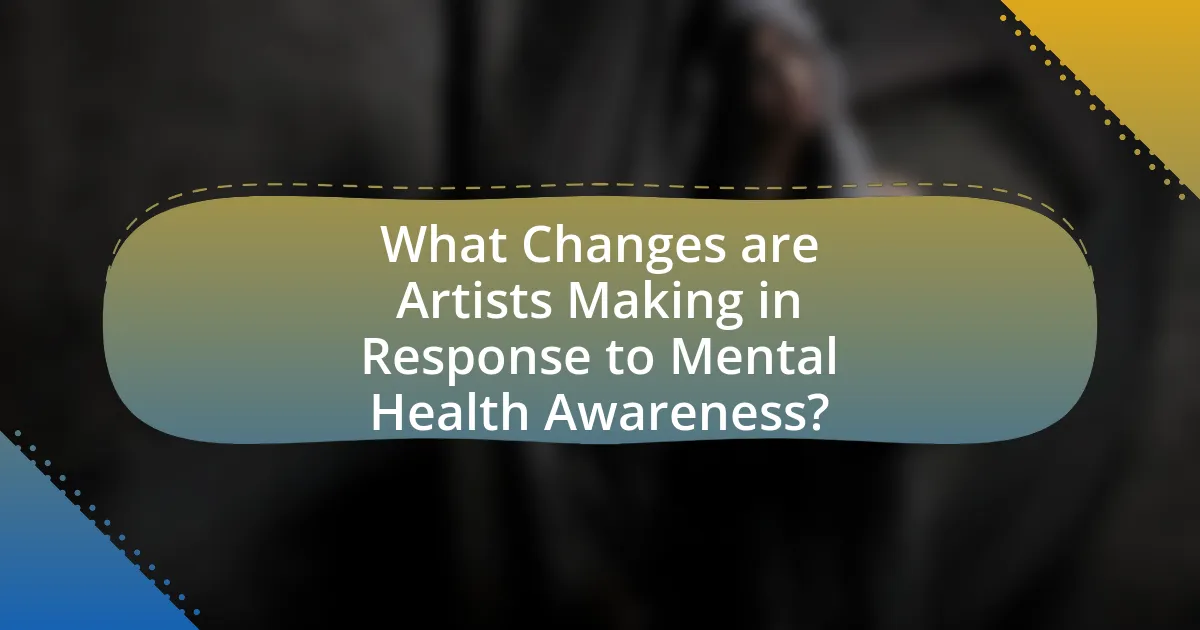
What Changes are Artists Making in Response to Mental Health Awareness?
Artists are increasingly incorporating themes of mental health into their work, utilizing their platforms to raise awareness and foster dialogue. This shift includes creating art that reflects personal experiences with mental health issues, such as anxiety and depression, which resonates with audiences and encourages openness. For instance, musicians like Logic have released songs addressing mental health struggles, while visual artists are producing pieces that depict the complexities of mental health, often sharing their own stories through social media. This trend is supported by research indicating that 1 in 5 adults experience mental illness, highlighting the relevance of these themes in contemporary art. Additionally, many artists are collaborating with mental health organizations to promote resources and support, further solidifying their role in advocating for mental health awareness.
How are artists incorporating mental health themes into their work?
Artists are incorporating mental health themes into their work by using various mediums to express personal experiences and societal issues related to mental well-being. For instance, visual artists often create pieces that depict emotions associated with mental health struggles, such as anxiety and depression, using colors and forms that evoke these feelings. Musicians frequently write lyrics that address mental health challenges, aiming to resonate with listeners who may share similar experiences. According to a study published in the Journal of Affective Disorders, 70% of artists reported that their work serves as a therapeutic outlet for their mental health issues, highlighting the connection between creativity and emotional expression. This integration of mental health themes not only raises awareness but also fosters dialogue around the importance of mental health in society.
What types of artistic expressions are emerging around mental health topics?
Emerging artistic expressions around mental health topics include visual arts, music, literature, and performance art. Visual artists are increasingly using mediums like painting and sculpture to depict mental health struggles, often incorporating personal narratives to foster connection and understanding. Musicians are creating songs that address mental health issues, with lyrics that resonate with listeners’ experiences, thereby promoting dialogue and awareness. In literature, authors are exploring mental health themes through fiction and poetry, providing insights into the complexities of mental illness. Performance art is also gaining traction, with artists using their bodies and spaces to convey emotional experiences related to mental health, often in interactive formats that engage audiences directly. These expressions reflect a growing societal recognition of mental health, as evidenced by increased public discussions and initiatives aimed at reducing stigma.
How do these themes resonate with audiences and communities?
Themes of mental health awareness resonate deeply with audiences and communities by fostering empathy and understanding. This connection is evident as individuals increasingly share personal experiences related to mental health, creating a sense of solidarity and reducing stigma. For instance, a 2021 survey by the National Alliance on Mental Illness found that 64% of respondents felt more comfortable discussing mental health issues due to increased public discourse, highlighting the impact of awareness campaigns. Furthermore, artists who openly address mental health in their work often find that their audiences relate to these themes, leading to greater engagement and support within communities. This collective response not only validates individual experiences but also encourages ongoing conversations about mental health, reinforcing its importance in society.
What support systems are artists seeking to promote mental well-being?
Artists are seeking various support systems to promote mental well-being, including peer support networks, mental health resources, and professional counseling services. Peer support networks provide a sense of community and shared experience, allowing artists to connect with others facing similar challenges. Mental health resources, such as workshops and online platforms, offer education and coping strategies tailored to the unique pressures of the creative industry. Professional counseling services, including therapy and mental health hotlines, provide individualized support to help artists navigate their mental health issues effectively. These systems are essential as they address the high rates of anxiety and depression reported among artists, emphasizing the need for accessible mental health care in the creative community.
How are collaborations and networks forming to support mental health?
Collaborations and networks are forming to support mental health through partnerships between artists, mental health organizations, and community groups. These collaborations often involve joint initiatives such as workshops, awareness campaigns, and fundraising events aimed at reducing stigma and providing resources for mental health support. For instance, organizations like MusiCares and the National Alliance on Mental Illness (NAMI) have partnered with artists to create programs that address mental health issues within the music industry, highlighting the importance of mental well-being among artists. Additionally, social media platforms are being utilized to connect individuals and organizations, fostering a community that shares resources and support, which has been shown to enhance mental health outcomes.
What resources are available for artists struggling with mental health issues?
Artists struggling with mental health issues can access various resources, including mental health hotlines, therapy services, and support groups specifically tailored for creatives. Organizations like the National Alliance on Mental Illness (NAMI) provide educational resources and support networks, while the Artist’s Health Alliance offers mental health services and workshops designed for artists. Additionally, the Creative Arts Therapies Association promotes therapeutic practices that utilize art for healing. These resources are validated by studies indicating that targeted support can significantly improve mental health outcomes for artists, highlighting the importance of accessible mental health care in the creative community.
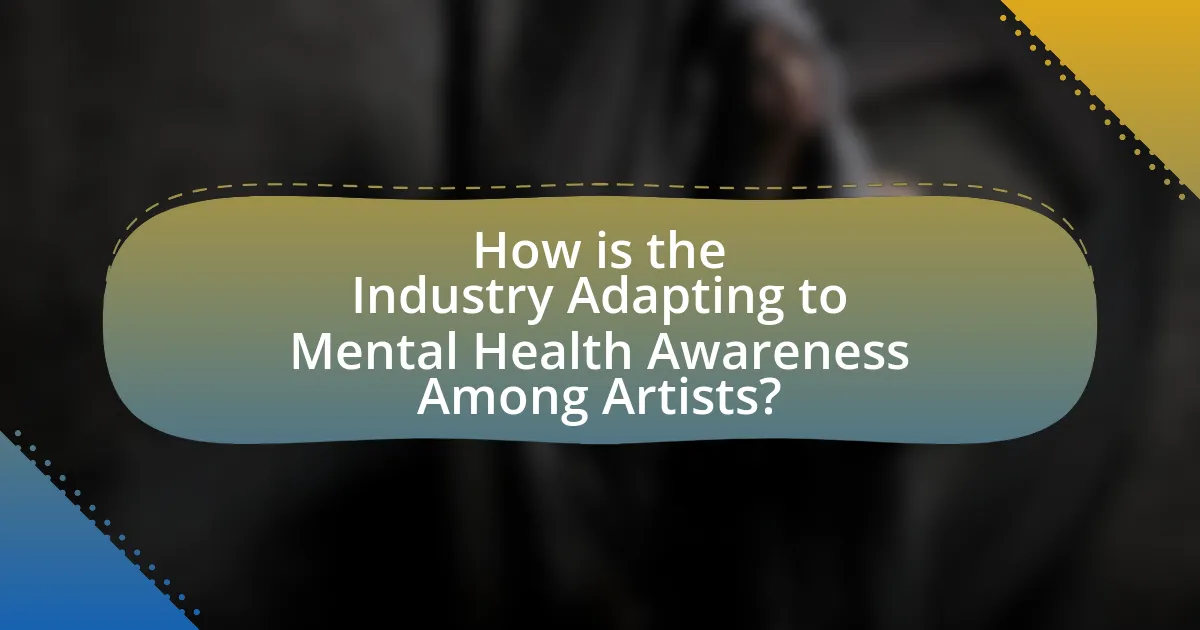
How is the Industry Adapting to Mental Health Awareness Among Artists?
The industry is adapting to mental health awareness among artists by implementing supportive measures such as mental health resources, training programs, and policy changes. For instance, major record labels and production companies are increasingly providing access to mental health professionals and creating initiatives aimed at reducing stigma around mental health issues. A survey conducted by the Music Industry Research Association in 2021 revealed that 73% of music professionals believe mental health support is essential for artists, leading to the establishment of programs like the Music Industry Mental Health Coalition, which promotes mental wellness in the industry. These adaptations reflect a growing recognition of the importance of mental health in sustaining artistic creativity and overall well-being.
What initiatives are being implemented by the industry to support artists’ mental health?
The industry is implementing various initiatives to support artists’ mental health, including mental health training programs, access to counseling services, and the establishment of peer support networks. For instance, organizations like Music Industry Mental Health Coalition provide resources and training to help industry professionals recognize and address mental health issues. Additionally, initiatives such as the “Wellness in Music” program focus on creating safe spaces for artists to discuss their mental health challenges openly. These efforts are backed by research indicating that mental health support can significantly improve artists’ well-being and productivity, as highlighted in studies by the University of Westminster, which found that 71% of musicians experience mental health issues at some point in their careers.
How are organizations and institutions changing policies related to mental health?
Organizations and institutions are changing policies related to mental health by implementing comprehensive mental health programs and integrating mental health support into workplace environments. For instance, many companies are adopting mental health days as part of their employee benefits, recognizing the importance of mental well-being in enhancing productivity and job satisfaction. According to a 2021 report by the World Health Organization, workplaces that prioritize mental health can see a return of $4 for every $1 invested in mental health initiatives, highlighting the economic benefits of such policies. Additionally, educational institutions are increasingly offering mental health resources and counseling services, reflecting a broader societal shift towards prioritizing mental health awareness and support.
What role do industry leaders play in promoting mental health awareness?
Industry leaders play a crucial role in promoting mental health awareness by leveraging their influence to initiate conversations and implement supportive policies. They can set industry standards that prioritize mental well-being, as seen in initiatives like the Music Industry Mental Health Task Force, which aims to improve mental health resources for artists and professionals. By publicly discussing mental health challenges and sharing personal experiences, leaders can destigmatize these issues, encouraging others to seek help. Research indicates that 1 in 5 adults experience mental illness, highlighting the importance of leadership in fostering an environment where mental health is openly addressed and supported.
How can the industry better support artists in their mental health journeys?
The industry can better support artists in their mental health journeys by implementing comprehensive mental health programs and resources tailored specifically for creative professionals. Research indicates that artists face higher rates of mental health issues, with a study published in the Journal of Affective Disorders revealing that 50% of artists experience anxiety and depression. By providing access to mental health services, workshops, and peer support networks, the industry can create a more supportive environment. Additionally, promoting open discussions about mental health within artistic communities can help reduce stigma and encourage artists to seek help when needed.
What best practices can be adopted to create a healthier work environment?
To create a healthier work environment, organizations should implement practices such as promoting open communication, providing mental health resources, and encouraging work-life balance. Open communication fosters a culture where employees feel safe discussing mental health issues, which can lead to early intervention and support. Providing mental health resources, such as access to counseling services or workshops, equips employees with tools to manage stress and anxiety effectively. Encouraging work-life balance through flexible work hours and promoting regular breaks can reduce burnout and enhance overall well-being. Research indicates that workplaces prioritizing mental health see a 30% increase in employee productivity and a significant decrease in absenteeism, demonstrating the effectiveness of these practices.
How can audiences contribute to a supportive culture for artists?
Audiences can contribute to a supportive culture for artists by actively engaging with their work and providing positive feedback. When audiences attend performances, purchase art, or share artists’ content on social media, they validate the artists’ efforts and encourage them to continue creating. Research indicates that positive reinforcement from audiences can significantly impact an artist’s mental well-being, as it fosters a sense of community and belonging. For instance, a study published in the Journal of Arts Management, Law, and Society found that supportive audience interactions can enhance artists’ resilience and reduce feelings of isolation, which are critical factors in maintaining mental health in the creative industry.
What practical steps can artists take to prioritize their mental health?
Artists can prioritize their mental health by establishing a structured routine that includes regular breaks, physical activity, and mindfulness practices. Research indicates that routines can enhance emotional stability and reduce anxiety, which is crucial for artists facing the pressures of creativity and deadlines. Additionally, engaging in physical activities like yoga or walking has been shown to release endorphins, improving mood and reducing stress levels. Mindfulness practices, such as meditation, can help artists stay present and manage overwhelming thoughts, contributing to better mental well-being. Furthermore, seeking professional support through therapy or counseling can provide artists with coping strategies tailored to their unique challenges in the creative industry.

